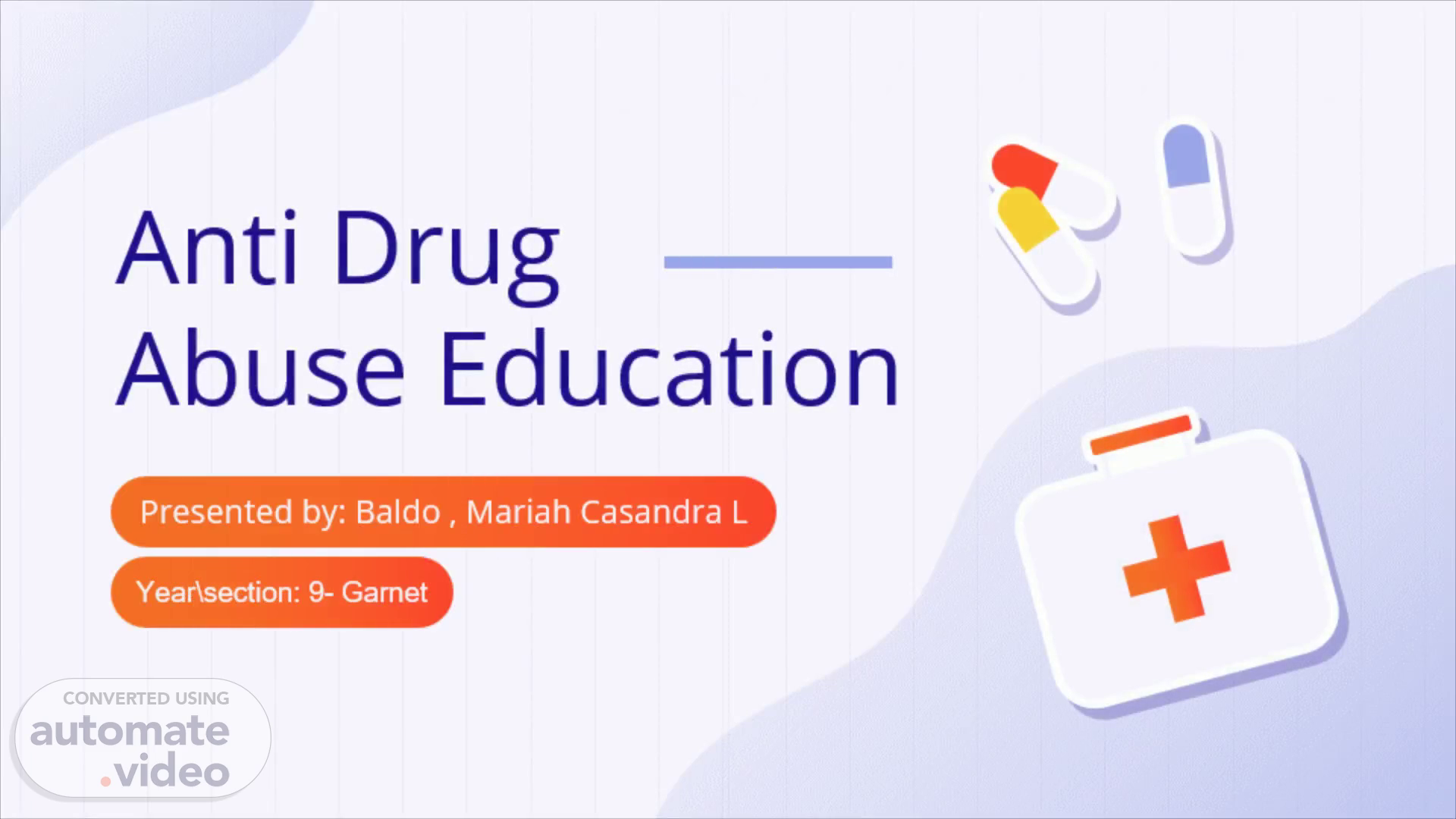
Page 1 (0s)
Anti Drug Abuse Education. Presented by: Baldo , Mariah Casandra L.
Page 2 (10s)
Table of contents of Anti Drug Abuse Education. Getting to know about Drug Abuse.
Page 3 (24s)
Getting to know about Drug Abuse. 01.
Page 4 (33s)
What is Drug Abuse?. Drug abuse or substance abuse refers to the use of certain chemicals for the purpose of creating pleasurable effects on the brain. There are over 190 million drug users around the world and the problem has been increasing at alarming rates, especially among young adults under the age of 30. Apart from the long term damage to the body drug abuse causes, drug addicts who use needles are also at risk of contracting HIV and hepatitis B and C infections ..
Page 5 (57s)
7 categories of Drugs. 02.
Page 6 (1m 5s)
7 DRUG CATEGORIES. Physicians have long recognized that different types of drugs affect people differently. Nonetheless, drugs may be categorized or classified according to certain shared symptomatologies or effects. The DRE categorization process is premised on these long-standing, medically accepted facts. DREs classify drugs in one of seven categories: Central Nervous System (CNS) Depressants, CNS Stimulants, Hallucinogens, Phencyclidine (PCP) and its analogs, Narcotic Analgesics, Inhalants, and Cannabis. Drugs from each of these categories can affect a person’s central nervous system an impair a person’s normal faculties, including a person’s ability to safely operate a motor vehicle..
Page 7 (1m 33s)
CNS Depressants slow down the operations of the brain and the body. Examples of CNS Depressants include alcohol, barbiturates, anti-anxiety tranquilizers (e.g., Valium, Librium, Xanax, Prozac, and Thorazine), GHB (Gamma Hydroxybutyrate), Rohypnol and many other anti-depressants (e.g., as Zoloft, Paxil)..
Page 8 (1m 53s)
(2) CNS Stimulants. CNS Stimulants accelerate the heart rate and elevate the blood pressure and “speed-up” or over-stimulate the body. Examples of CNS Stimulants include Cocaine, “Crack”, Amphetamines and Methamphetamine (“Crank”)..
Page 9 (2m 7s)
(3) Hallucinogens. Hallucinogens cause the user to perceive things differently than they actually are. Examples include LSD, Peyote, Psilocybin and MDMA (Ecstasy)..
Page 10 (2m 18s)
(4) Dissociative Anesthetics. One of the seven drug categories. It includes drugs that inhibit pain by cutting off or dissociating the brain’s perception of the pain. PCP and its analogs are examples of Dissociative Anesthetics ..
Page 11 (2m 32s)
(5) Narcotic Analgesics. A narcotic analgesic relieves pain, induces euphoria and creates mood changes in the user. Examples of narcotic analgesics include Opium, Codeine, Heroin, Demerol, Darvon, Morphine, Methadone, Vicodin and OxyContin..
Page 12 (2m 46s)
(6) Inhalants. Inhalants include a wide variety of breathable substances that produce mind-altering results and effects. Examples of inhalants include Toluene, plastic cement, paint, gasoline, paint thinners, hair sprays and various anesthetic gases ..
Page 13 (3m 0s)
(7) Cannabis. Cannabis is the scientific name for marijuana. The active ingredient in cannabis is delta-9 tetrahydrocannabinol, or THC. This category includes cannabinoids and synthetics like Dronabinol...
Page 14 (3m 13s)
03. Examples and Images of Drugs Presented.
Page 15 (3m 21s)
Drugs that are classified as CNS depressants include: Alcohol Barbiturates Benzodiazepines Many Sleeping Pills Opioids.
Page 16 (3m 35s)
Central nervous system stimulants used for attention deficit disorder, narcolepsy or excessive sleepiness include the amphetamines, methylphenidate, atomoxetine, modafinil, armodafinil, pitolisant and solriamfetol ..
Page 17 (3m 51s)
Types of hallucinogens: LSD, mescaline, psilocybin, PCP, cannabis, ecstasy, ketamine, salvia and others..
Page 18 (4m 5s)
Many d issociative drugs have general depressant effects on the body. These may include:Respiratory depression Analgesia (pain relief)Anesthesia (temporary loss of awareness)Ataxia (uncontrollable muscle movements)Amnesia (memory impairment).
Page 19 (4m 20s)
Examples of narcotic analgesic besides morphine are buprenorphine, fentanyl, and tramadol..
Page 20 (4m 31s)
most often used are shoe polish, glue, toluene,1 gasoline, lighter fluid, nitrous oxide2 or “whippets,” spray paint, correction fluid, cleaning fluid, amyl nitrite3 or “poppers,” locker room deodorizers or “rush,” and lacquer ..
Page 21 (4m 49s)
Marijuana − the dried leaves and flowers (buds) of the cannabis plant that are smoked in a joint or a bong. This is the most common form..
Page 22 (5m 4s)
UNODC Prevention, Treatment, and Rehabilitation Section supports Member States in addressing drug use and drug use disorders as any other health condition, that is by implementing drug use prevention strategies and providing treatment, health care, social protection and rehabilitation services, including for children and adolescents, based on scientific evidence, human rights and gender considerations. Another area of work is promoting access to controlled drugs for medical purposes, whilst preventing diversion and abuse. Click on the links below to know more about UNODC activities and resources in: - Drug use prevention including through youth participation - Treatment, care and rehabilitation of drug use disorders - Services for children exposed to drugs at a very young age - Access to controlled drugs for medical purposes.
Page 23 (5m 37s)
Thanks. Do you have any questions?.